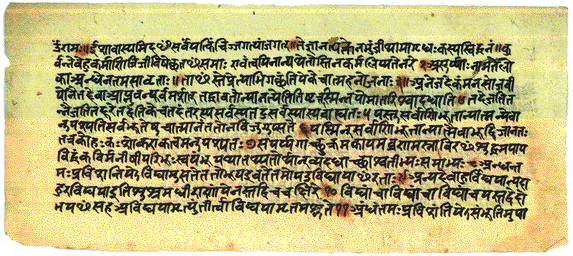Vedānta is a word that is used in Indian culture (specifically Hinduism) to describe Indian philosophy about the relationship between atman, and Brahman. Many consider Vedānta to be “the philosophy of Hinduism.” The use of the word Atman is referring to one’s true self while Brahman refers to a supreme reality or the Absolute (God). Brahman is a general Hindu term that is used in philosophy to describe pretty much everything; God as a whole, reality, earth, time, space, energy, etc. It’s an eastern culture terms that can be hard to wrap your mind around mostly because western culture typically doesn’t think that way. Also, the term Vedānta is a term that comes specifically from the Veda (knowledge) text that is referred to as the Upanishads that date back to 800BC. The older view of Vedānta is one where many authors and schools contributed to the thoughts and creation of the Vedānta. More recently though, Vedānta is more of a “folklore” or “spiritual” since that has been derived from the Upanishads.
The Upanishads are old texts in Hindu that don’t have a specific author or authors although there is a list of main authors that contributed to most of its creation. Most of the texts have been passed down through oral traditions over time. The majority of the texts are believed to be written from the Pre-Buddhist time to around the first centuries BC, however, some were even written up to the medieval period.
The Upanishads are old texts in Hindu that don’t have a specific author or authors although there is a list of main authors that contributed to most of its creation. Most of the texts have been passed down through oral traditions over time. The majority of the texts are believed to be written from the Pre-Buddhist time to around the first centuries BC, however, some were even written up to the medieval period.
Isa Upanishad
I
All this, whatsoever exists in the universe, should be covered by the Lord. Having renounced (the unreal), enjoy (the Real). Do not covet the wealth of any man. We cover all things with the Lord by perceiving the Divine Presence everywhere. When the consciousness is firmly fixed in God, the conception of diversity naturally drops away; because the One Cosmic Existence shines through all things. As we gain the light of wisdom, we cease to cling to the unrealities of this world and we find all our joy in the realm of Reality.
V
It moves and It moves not. It is far and also It is near. It is within and also It is without all this. It is near to those who have the power to understand It, for It dwells in the heart of every one; but It seems far to those whose mind is covered by the clouds of sensuality and self– delusion. It is within, because It is the innermost Soul of all creatures; and It is without as the essence of the whole external universe, infilling it like the all–pervading ether.
VI
He who sees all beings in the Self and the Self in all beings, he never turns away from It (the Self).
Chandogya Upanishad 6.13.1-3
Uddalaka said “Put this salt in water, and come to me tomorrow morning.” Svetaketu did as he was bidden. The next morning his father asked him to bring the salt which he had put in the water. But he could not, for it had dissolved. Then said Uddalaka: “Sip the water, and tell me how it tastes.” “It is salty, sir.”
“In the same way,” continued Uddalaka, “though you do not see Brahman in this body, he is indeed here. That which is the subtle essence–in that have all things their existence. That is the truth. That is the Self. And that, Svetaketu, THAT ART THOU.”
I
All this, whatsoever exists in the universe, should be covered by the Lord. Having renounced (the unreal), enjoy (the Real). Do not covet the wealth of any man. We cover all things with the Lord by perceiving the Divine Presence everywhere. When the consciousness is firmly fixed in God, the conception of diversity naturally drops away; because the One Cosmic Existence shines through all things. As we gain the light of wisdom, we cease to cling to the unrealities of this world and we find all our joy in the realm of Reality.
V
It moves and It moves not. It is far and also It is near. It is within and also It is without all this. It is near to those who have the power to understand It, for It dwells in the heart of every one; but It seems far to those whose mind is covered by the clouds of sensuality and self– delusion. It is within, because It is the innermost Soul of all creatures; and It is without as the essence of the whole external universe, infilling it like the all–pervading ether.
VI
He who sees all beings in the Self and the Self in all beings, he never turns away from It (the Self).
Chandogya Upanishad 6.13.1-3
Uddalaka said “Put this salt in water, and come to me tomorrow morning.” Svetaketu did as he was bidden. The next morning his father asked him to bring the salt which he had put in the water. But he could not, for it had dissolved. Then said Uddalaka: “Sip the water, and tell me how it tastes.” “It is salty, sir.”
“In the same way,” continued Uddalaka, “though you do not see Brahman in this body, he is indeed here. That which is the subtle essence–in that have all things their existence. That is the truth. That is the Self. And that, Svetaketu, THAT ART THOU.”

 RSS Feed
RSS Feed